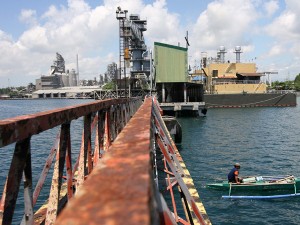
A fisherman passes by Holcim compound where the Power Barge 104 is anchored (Barangay Ilang, Davao City, Davao Gulf area). An energy watch group on Saturday, June 15, 2013, blamed the Electric Power Industry Reform Act as causing the government to lose control of the power industry and allowing private businesses to raise power rates any time they choose. INQUIRER FILE PHOTO
ILIGAN CITY, Philippines—The Electric Power Industry Reform Act (Epira) has caused the government to lose control of the power industry, which is why private businesses can now raise power rates any time they choose, an energy watch group said Saturday.
This is the main reason the Power Alternative Agenda (Palag)-Mindanao wants the Epira law amended, if not totally scrapped, said Jong Cadion of Palag.
Cadion said that unless the Epira law was scrapped or amended, it would never be possible to return control of the power industry to the government.
“Power rates will continue to accelerate and that will surely affect not just the individual family but it will also continue to undermine the economic advantage of Mindanao,” he said.
The Electric Power Industry Reform Act of 2001, which liberalized and privatized the power industry, was aimed at bringing down power rates and improving the delivery of supply through greater competition and efficiency.
However, more than a decade after the law’s enactment, high electricity rates and power outages, particularly in Mindanao, continue to be the lot of consumers.
Various consumer and activist groups have called for the repeal of Epira and the return of government regulation over the power industry to protect consumers and ensure affordable energy.
Recently, power coops in Mindanao said consumers would have to pay more beginning July as they would be using modular generator sets to address the “power woes” brought about by the declining water level in Lake Lanao.
Lake Lanao is the source of the Agus hydropower system, which accounts for the bulk of the electricity feeding into the Mindanao grid.
The lake’s declining water level has also prompted the National Power Corp., the state generator, to implement a Mindanao-wide load curtailment scheme, which has caused daily power outages of up to eight hours in some areas.
In this city, the Iligan Light and Power Co. (ILPC) said that while it will not be using modular generator sets it also has to raise power rates—by about P3 per kilowatt hour—because of the added costs from the electricity supply contract it has with two companies operated by Alsons Consolidated Resources.
Keenan Erigbuagas, ILPC customer services supervisor, explained that the distribution utility has had to buy more electricity from other providers because of the supply deficiency.—Tito Fiel

